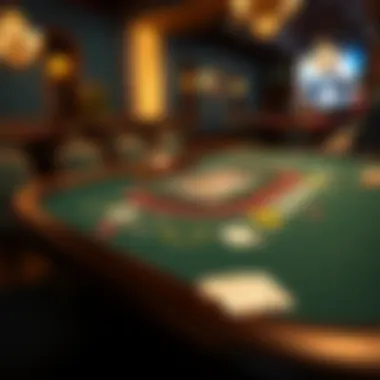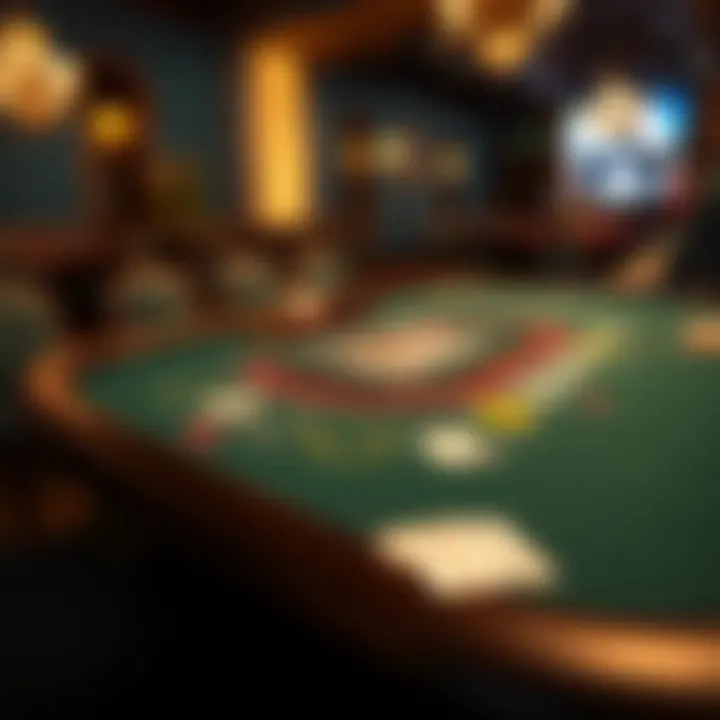Mastering Blackjack: A Comprehensive Guide


Intro
Blackjack is not just another card game in the dim-lit corners of a casino; it’s a battleground of wits and chance where each hand can shift the tides of fortune. This guide seeks to illuminate the creases of blackjack, revealing its enticing gameplay, strategies, and the underlying nuances that define the gambling experience. In this comprehensive portrayal, we will dissect the rules that govern the game, the strategies that can tilt the odds in your favor, and the gambling culture that surrounds it. Whether you're a novice stepping into the world of casinos or a seasoned player looking to refine your craft, this guide promises to deepen your understanding.
Game Mechanics and Strategies
Understanding the Rules of Popular Games
At its core, blackjack is simple. The objective is clear: beat the dealer by having a hand value closer to 21, without exceeding it. The nuances arise when you explore the variations of the game. Consider, for instance, the differences between classical blackjack and games like European or Vegas Strip blackjack. Each has its own set of rules regarding the dealer's behavior and the number of decks used.
In addition to understanding these distinctions, it’s vital to familiarize oneself with the basic terminology and actions:
- Hit: Requesting an additional card.
- Stand: Holding your total and ending your turn.
- Double Down: Doubling your bet and receiving only one more card.
- Split: Dividing a pair into two separate hands.
As you play, staying aware of the value of your hand and the dealer's upcard can provide a substantial advantage. This leads us naturally into strategy formulation—the bedrock of successful gameplay.
Advanced Strategies for Winning
Once you've grasped the basic rules, it’s time to elevate your game. Many seasoned players delve into strategic methodologies like card counting or the use of basic strategy charts. While card counting often conjures images of high-stakes film plots, it’s less about complex mathematics and more about maintaining an awareness of the ratio of high to low cards left in the deck.
Employing a basic strategy chart can also keep you on the right path. These charts deduce the optimal moves based on your hand and the dealer's visible card.
"Proper strategy can reduce the house edge significantly, often down to less than 1% if executed correctly."
Among advanced tactics, consider the concept of bankroll management. Setting limits on your losses and knowing when to walk away are crucial components of a proficient gambling mindset. This discipline ensures that, whether you experience winning or losing streaks, you remain in control.
Gambling Culture and Trends
Evolution of Casino Gaming
The landscape of casino games, especially blackjack, has evolved radically since its origins, reflecting broader changes in societal attitudes towards gambling. From its earliest forms in the 17th century to the glitzy Las Vegas establishments, each phase tells a story of cultural transformation.
With the advent of online gaming platforms, players now enjoy the added convenience of playing from home. Virtual tables have introduced new demographics into the game, mixing traditional players with digital natives. The seamless integration of technology in gambling has not only changed gameplay but also transformed how we perceive strategy and engagement within the casino ecosystem.
Insights into Responsible Gambling Practices
As the popularity of blackjack surges, so does the importance of responsible gambling. It’s essential to approach the game with a mindset that promotes balance. Setting time and budget constraints is imperative in enjoying the game while mitigating risks. Resources are readily available for those seeking to understand the psychological facets of gambling, including organizations like the National Council on Problem Gambling (ncpgambling.org). You can also find community advice on platforms such as reddit.com.
Gambling culture today emphasizes education and awareness. Many casinos actively promote responsible practices, providing players with the tools they need to engage in gambling as a recreational activity rather than a perilous endeavor.
This guide serves not just as an informative piece but as an invitation to delve deeper into the multifaceted realm of blackjack, equipped with strategies and an understanding of the culture that shapes it.
Preface to Blackjack
The game of blackjack, often referred to as twenty-one, has carved a niche for itself within the expansive realm of casino gaming. This section lays the foundational understanding of blackjack as a captivating pursuit that blends chance with strategy, which is why diving deep into its nuances is crucial. For both novices and seasoned players, comprehending the basics sets the stage for not only enjoyment but also for devising effective strategies that could tilt the odds in one's favor.
History and Evolution of the Game
Blackjack’s origins can be traced back to the 17th century in France. At that time, it went by various names, but the most widely known was "vingt-et-un", translating to twenty-one. Its evolution reflected cultural transitions, with the game migrating across oceans to the United States, adapting to American gambling styles. The name blackjack itself emerged from a specific bonus payout during the early 20th century when a player’s hand included the ace of spades and a black jack—thus capturing the essence of luck paired with strategic acumen.
As the years rolled on, blackjack underwent several adaptations. The simple rules and relatively low house edge contributed to its surge in popularity. Many variations sprouted in casinos, like American and European blackjack, each imposing its unique set of rules, creating an increasingly diverse landscape for enthusiastic gamblers.
Understanding the Game's Popularity
So, why has blackjack remained a beloved choice among casino-goers? Well, for one, it offers players a unique combination of skill and luck. Unlike other games solely driven by chance, blackjack invites strategy and player decision-making, which heightens the thrill.
Also, its straightforward rules make it approachable. A first-time player can quickly grasp the basics without feeling overwhelmed, unlike poker, which can be a more complex affair involving intricate strategies and betting concepts. To put it simply, it’s like teaching someone to swim; blackjack gets you in the shallow end first before you can dive into deeper waters.
Moreover, social interaction plays a vital role. The camaraderie at a blackjack table often fosters excitement, drawing in not just individual players but groups who enjoy the collective experience. In casinos, the energy shifts dynamically as players cheer each other on, creating a lively atmosphere that’s hard to replicate.
In summary, the allure of blackjack lies not only in its rich history of evolution but also in its unique blend of strategy, simplicity, and social engagement. Understanding these elements is key for anyone looking to explore or enhance their gameplay.
Basic Rules and Gameplay Mechanics
Understanding the basic rules and gameplay mechanics of blackjack is essential for both new and experienced players. These foundational elements set the stage for strategic decision-making and influence the overall success at the table. Getting a grip on how the game unfolds allows players to navigate the casino environment confidently, making informed choices while trying to beat the dealer.
Objective of the Game


The primary aim in blackjack is simple: achieve a hand value that beats the dealer's without exceeding 21. Players strive for a total closer to 21 than the dealer’s hand, utilizing the value of the cards dealt. In practical terms, this objective translates into a battle of wits where, sometimes, strategy can outweigh sheer luck.
Most gamblers get drawn into the thrill of this competitive aspect. Winning when going against the dealer can incite intense feelings of excitement. It adds layers of strategy which often entice players to hone their skills. In blackjack, getting a blackjack itself, a combination of an ace and a ten-value card, is the golden ticket as it pays better than regular wins, often 3:2.
Card Values and Hand Rankings
Card values hold the key to mastering gameplay mechanics:
- Number Cards (2-10): These carry their face value.
- Face Cards (Jack, Queen, King): Each valued at 10.
- Aces: These can either be 1 or 11, depending on what benefits your hand the most.
The ranking of hands in blackjack is crucial. For instance, a total of 19 is always going to beat a total of 17 in a head-to-head face-off with the dealer. A player's ability to recognize these values quickly and intuitively will allow for smarter decisions during play.
Important Note: Always be mindful of the dealer’s upcard, as it plays a significant role in your approach and strategy.
Gameplay Flow: Turns and Actions
The flow of gameplay is distinctly structured, which helps players formulate plans and responses:
- Placing Bets: The round begins with players placing their bets before cards are dealt.
- Dealing Cards: Each player receives two cards, with one of the dealer’s cards face up.
- Player Decisions: Players can choose to hit (take another card), stand (keep their hand), double down (double the bet and take only one more card), or split (if holding two cards of the same value).
- Dealer's Turn: After players finish their turns, the dealer reveals their hole card and follows a specific set of rules that dictate hitting or standing, typically hitting until they reach 17 or higher.
- Resolution: Winning hands are determined, and payouts are made accordingly.
This sequence lays the groundwork for what many refer to as the dance at the blackjack table. Each decision not only affects your standing in the game but also contributes to the dynamics among players and actions taken against the dealer's hand. Understanding this flow is pivotal for effectively executing strategies.
By grasping these basic rules and gameplay mechanics, players can engage with the game on a deeper level. The rules are as much about understanding the strategies behind them as they are about simple execution. For further exploration, you might find value in the resources available at Wikipedia on Blackjack or discussions on Reddit's Gambling Community for unique insights into gameplay experiences and strategies.
Types of Blackjack Variations
Blackjack is not a one-size-fits-all kind of game. The diversity in its variations caters to differing player preferences and style. Understanding these differences allows players to select the version that best suits their skills and desired experience. Whether you’re a newcomer dipping your toes or a seasoned gambler looking to sharpen your strategy, knowing the specific elements and benefits of each variation enhances your overall gameplay. Let’s chart these variations and explore their distinctive features.
Classic Blackjack
Classic Blackjack is the original form of the game, and it's where most people begin their blackjack journey. The objective remains the same across variations—beat the dealer by getting as close to 21 without going over.
- Gameplay: Players are dealt two cards and can choose to hit, stand, double down, or split pairs.
- Dealer Rules: Typically, the dealer stands on a soft 17, which is a hand containing an Ace valued as 11 without busting.
- Payouts: A natural blackjack, which is an Ace and a ten-value card, usually pays out at 3:2, which is quite favorable for players.
Classic Blackjack’s simplicity doesn’t mean it’s lacking in strategy. Instead, it serves as the perfect canvas for players to develop their approach.
European Blackjack
European Blackjack brings a slight twist to the game that attracts many enthusiasts. In this version, players start with only two cards, and the dealer checks for a natural blackjack only after the players have completed their turns.
- Key Differences:
- The dealer only receives one card face up at the start, waiting to draw their second until all player actions are completed.
- Doubling down is permitted only on certain hands, often limited to two initial cards.
This variation tends to lean more towards strategy, as players cannot base their decisions on a dealer’s hidden card until later in the game, thereby adding a delicious layer of suspense.
American Blackjack
When it comes to American Blackjack, the stakes rise a bit. Here, players are presented with more opportunities during the game but also face certain risks.
- Gameplay Mechanics: Similar to Classic Blackjack, the significant difference is the dealer draws two cards, one face up and one face down.
- Insurance Bets: If the dealer shows an Ace, players can opt for insurance, a side bet against the dealer having a natural blackjack. This option can be risky, but seasoned players have their own takes on when to use it.
- Payouts: Just like Classic Blackjack, natural blackjacks usually pay 3:2 here as well.
Overall, American Blackjack gives players a bit more leeway to make decisions, which can be exciting but also might lead to unexpected pitfalls.
Multi-Hand Blackjack
As the name implies, Multi-Hand Blackjack allows players to take on multiple hands simultaneously. This variation is ideal for those who thrive on increasing their stakes and strategizing exhaustively.
- Core Concept: Players can play two, three, or even up to five hands at once against the dealer. This brings a different rhythm to the game.
- Strategy Realignment: Managing multiple hands requires keen focus, and players need to think several steps ahead to maximize their chances of winning.
While it’s exhilarating, the layered complexity of managing multiple hands means players must really hone their basic strategy, making it a favorite among gambling strategists.
Understanding the variations of blackjack is akin to knowing your weapons before entering a battlefield. Each version has its unique charm and strategy, and a savvy player learns fully to navigate their chosen game.
In summary, recognizing the different types of blackjack variations is fundamental. Doing so not only prepares players mentally but also enhances the enjoyment as they dive deeper into gameplay. Whether one opts for Classic's simplicity or Multi-Hand’s complexity, the journey through these variants is sure to be rich in experience and learning.
Strategies for Success


Understanding strategies for success in blackjack is like having a well-worn roadmap before you embark on a long journey. Navigating the complexities of the game requires more than just luck; it demands a structured approach. Players who methodically strategize increase their chances of walking away from the table with a smile instead of a frown. In this section, we’ll dive into several crucial components that can help shape your gameplay in blackjack.
Basic Strategy Charts
Basic strategy charts serve as essential tools for any blackjack player. These charts outline the statistically most effective actions to take based on the player’s hand and the dealer's visible card. It’s akin to having a cheat sheet—easy to reference and helps you make swift decisions.
- Understanding the Chart: Each hand's action—whether to hit, stand, double down, or split—is laid out with precision. The chart at times resembles a flowchart but is more straightforward. For example, if you hold 16 and the dealer shows a 10, the chart may suggest hitting, as it's statistically unlikely that you’ll bust on another card.
- Benefits of Use: Utilizing these charts improves your gameplay efficiency. Players who strictly adhere to these guidelines can reduce the house edge significantly, often down to around 0.5% depending on the specific rules of the game. This small margin can amount to substantial savings over time.
Advanced Techniques: Card Counting
Card counting might sound like something only the pros do, but it’s not as out of reach as one might think. While it involves some level of mathematical skill, it primarily hinges on the ability to keep track of the ratio of high-value cards to low-value cards remaining in the deck. Players can glean valuable information about when to increase their bets.
- How It Works: The most common method is the Hi-Lo strategy, where players assign a point system to the cards as they are dealt. High cards (10s, face cards, and Aces) are assigned a negative value, while low-value cards (2 to 6) are positive. Cards in the middle (7 to 9) hold no value.
- Key Considerations: Before attempting card counting, be aware of the casino’s attitudes. Some establishments take a dim view of this strategy and will ask players suspected of counting to leave.
When to Hit, Stand, or Double Down
Deciding when to hit, stand, or double down is perhaps one of the most nuanced aspects of the game. Players often struggle here, overthinking their decisions or relying solely on gut feelings. Taking a strategic approach can greatly enhance results.
- Hitting and Standing: The fundamental rule is to hit when you think your hand is too weak to win, generally under 12, especially against a dealer's strong showing. Standing, on the other hand, usually happens when you feel confident your total can beat the dealer's hand.
- Doubling Down Made Simple: This option can be seen as a gamble worth taking. It typically works best when you have a total of 10 or 11, and the dealer has a 5 or 6 showing. This situation offers a solid chance of delivering a robust hand with just one additional card.
"The strategy is your compass and can mean the difference between winning and going home empty-handed."
By understanding and implementing these strategies, one begins to grasp the core of blackjack. The combination of basic strategy charts, potential for card counting, and making informed decisions on hitting, standing, or doubling down embarks the player on a path toward mastery.
For further insights, check resources like Wikipedia on Blackjack, where you can find a wealth of knowledge on the game’s strategies and rules.
The Role of Casino Etiquette
In the world of blackjack, etiquette isn't just about following a set of rules—it's about ensuring a pleasant experience for everyone involved. Understanding and adhering to proper practices at the table can significantly enhance the enjoyment of the game, both for you and your fellow players.
Understanding Table Manners
Table manners in blackjack are essential for maintaining a positive atmosphere. It’s not just about what you do; it’s how you do it. A few key points to consider include:
- Respect Personal Space: Each player has their own area; keep your personal items and yourself within your designated zone. It’s uncomfortable for others if the shoulder is rubbing against theirs.
- Handling Chips: When it comes to chips, treat them with care. Place them on the table rather than throwing them. This might seem trivial, but it shows respect towards the table and other players.
- Be Mindful of Timing: Taking your time is good, but dragging it on too long can frustrate others. Make decisions at a reasonable pace. If you're undecided, it's alright to ask questions, but prolonged hesitation can upset the flow of the game.
Maintaining good table manners not only reflects well on you but also sets a standard for others to follow. It helps create a respectful environment conducive to a good game.
Communicating with Dealers and Players
Effective communication can dramatically alter your blackjack experience. It facilitates smooth play and helps everyone feel included. Here’s how to navigate conversations at the table:
- Address the Dealer Politely: Start with a simple greeting. Acknowledging the dealer does not only show your courtesy but also begins the interaction on a positive note. You might say something like, "Hello, how's your night going?"
- Use Appropriate Signals: If you wish to hit or stand, signal clearly without ambiguity. A nod for standing or waving your hand to hit helps the dealer understand your intentions without confusion.
- Discussing with Fellow Players: Feel free to chat with other players, but keep the noise level to a minimum. Excessive banter can distract everyone. Complimenting a good hand or sharing insights about strategy can be beneficial, but maintain an air of professionalism.
"The key to a successful experience at the blackjack table lies in respect—toward the dealers, other players, and the game itself."
Overall, understanding and respecting these untold rules of casino etiquette will make you a well-regarded player, likely earning respect and camaraderie at the table. It paves the way for a more enjoyable blackjack experience where every player can focus on the game. Not only does this help in developing positive relationships within the casino community, but it also contributes to a more immersive gaming experience. For more insights into game etiquette, consider visiting resources such as gamblingcommission.gov or learn-casino.com.
Psychological Aspects of Playing Blackjack
Understanding the psychological elements of blackjack is crucial for players aiming to improve their overall performance and enjoyment of the game. Gambling is not just about the cards you hold; it’s also about the mindset you bring to the table. The right frame of mind can make a world of difference in decision-making, emotional control, and ultimately, your success on the felt. This section dives into the nuances of managing your emotions and grasping the concepts of risk and reward.
Managing Emotions at the Table
When nerves start to jangle and excitement turns to anxiety, a player’s capacity to make sound decisions often flies right out the window. Managing one’s emotions is a delicate exercise. For some, it might feel like walking a tightrope; one slight misstep and you could plunge into frustration or reckless behavior.
If you are sitting at a blackjack table and the cards just aren’t falling in your favor, it can be easy to chase your losses. This is where emotional resilience becomes paramount. Consider these tips:
- Recognize Your Feelings: Acknowledge when frustration or excitement takes hold. Simply being aware of your emotions can help you regain focus.
- Take Breaks: Stepping away from the table, even for a minute, can help clear your mind. Use this time to take deep breaths and reset your thoughts.
- Stick to Your Strategy: Remember that sticking to a pre-determined strategy is often more beneficial than going with your gut feelings, which may be skewed by current emotions.
"The best players are those who keep their brains cool and their emotions in check. A flush of anger or elation can derail the best-laid plans."
Controlling emotions isn’t just about keeping calm; it’s also about harnessing the right mindset during those thrilling moments at the table. Think about how you feel after a big win - euphoria can lead to overconfidence. Strike a balance, keeping in mind that every game is a new challenge.
Understanding Risk and Reward
Gambling inherently involves risk but understanding that risk and its potential rewards is essential for any blackjack player. This notion can shape your gameplay significantly. When you sit at that table, you're not just playing cards; you're making choices that can lead to outcomes of varying degrees of consequence.


A simple way to decipher this relationship is through:
- Weighing Odds: Understand the odds of your hand against that of the dealer. Not every hand is a golden opportunity; sometimes, folding is the wise choice, even if it feels counterintuitive.
- Evaluating Bets: Consider your betting size against the potential payoff. Small bets can often lead to a steady climb while large bets might result in significant jumps or gaps in your bankroll.
- Long-term Perspective: It helps to view blackjack as a long game rather than seeking immediate gratification. The highs and lows are part of the journey.
Knowing when to take risks and when to play it safe can set apart the novice players from the seasoned pros. Again, it’s all about balance. Making calculated decisions that consider both the thrills and the potential pitfalls will serve you well at the blackjack table.
Technological Impact on Modern Blackjack
In today's fast-paced world, technology plays a pivotal role in how we experience gambling, especially blackjack. The integration of modern technology into the game has transformed traditional casino experiences into something that's both more accessible and engaging for players. This section dives into the significance of these changes, illuminating how online platforms and live dealer options cater to gamblers craving both convenience and authenticity.
Online Blackjack Platforms
The rise of online blackjack platforms has brought a wealth of opportunities for players. These platforms offer an assortment of games, ensuring that each player can find a version that suits their style and comfort level. One key highlight is the convenience of playing from home; you can participate in high-stakes games without having to deal with the hustle and bustle of a physical casino.
Moreover, online blackjack sites provide various tools that enhance the gameplay experience, including statistics, history tracking, and even chat functions to interact with other players. This means while you are at the table, you’re more connected than ever, even if it’s virtual. A few points to consider about online blackjack include:
- Flexibility: You can play anytime, anywhere, without the restrictions of casino hours.
- Bonuses and Promotions: Many sites offer enticing welcome bonuses or loyalty programs that can be a great boost for your bankroll.
- Variety: With a multitude of variations available, from classic to more obscure versions, players can always try something new and exciting.
However, it’s important to cautiously assess the trustworthiness of online platforms. Make sure to check for valid licenses and read reviews from fellow players. This way, you’ll avoid the proverbial wolf in sheep's clothing.
Live Dealer Experiences
For those who yearn for the authenticity of a brick-and-mortar casino yet still appreciate the perks of technology, live dealer experiences offer a compelling solution. These platforms simulate the real casino atmosphere by streaming live games directly to players' devices. Players can see the dealer and table in real-time, making decisions and interacting just as they would if they were sitting at a physical table.
Some notable aspects of live dealer blackjack are:
- Human Interaction: Unlike standard online games, you can chat with the dealer and other players, boosting the social aspect that many enjoy.
- Real-Time Feedback: As you make decisions, you see the outcome immediately, mimicking the traditional blackjack experience more closely.
- Trust and Fairness: With visibility of cards and dealers, many players find live dealer games instill a sense of security, knowing they're playing in a fair environment.
"The rise of technology in blackjack is not just about convenience; it’s a bridge connecting players to an authentic casino experience, regardless of their location."
Responsible Gambling Practices
In the fast-paced world of blackjack, the thrill of hitting a winning hand can be electrifying. Yet, beneath the surface of excitement lies the necessity for responsible gambling practices. Understanding this concept doesn't just keep one's finances in check; it also fosters a healthier, more sustainable relationship with the game. This segment illuminates the core aspects of responsible gambling and its significance in enhancing the overall gaming experience.
Setting Betting Limits
Establishing clear betting limits before you even touch the cards is akin to putting up guard rails on a winding road. It keeps you on track and prevents you from veering into risky territory. By specifying the maximum loss you’re willing to absorb per session, you create a buffer that shields your bankroll from impulsive decisions.
Think of it this way: when you enter a casino or sit down for a game online, you should have a game plan at the ready. Determine a budget that won't disrupt your regular expenses or responsibilities. Once set, stick with it! Here are some reasons why setting limits is crucial:
- Creates Awareness: You become more cognizant of your spending habits.
- Mitigates Risks: Fewer chances of overspending or chasing losses.
- Enhances Fun: Keeping betting in check allows you to enjoy the game without financial stress.
Take a leaf from experienced players—use tools offered by many casinos, such as account controls that let you set daily, weekly, or monthly limits. By doing so, you’re taking a proactive step towards ensuring your gambling remains what it should be: an enjoyable pastime.
Recognizing Problem Gambling
Recognizing problem gambling before it escalates is vital. The signs may not always be glaring, but being aware of them can make all the difference. Problem gambling can manifest in various forms, such as constantly thinking about gambling, feeling anxious when not playing, or lying about the extent of your gambling habits. It’s essential to understand that gambling, while entertaining, can spiral out of control for some if left unchecked.
"The first step in addressing a problem is recognizing it."
Awareness is power. Here are some checkpoints to consider:
- Emotional Indicators: Feelings of guilt or remorse after playing can signal a deeper issue.
- Financial Red Flags: Constantly borrowing money to gamble or experiencing significant financial hardship.
- Neglecting Responsibilities: If gambling starts to interfere with personal or professional obligations, it might be time for a pause.
If you or someone you know is struggling, seek help. Resources are available through organizations like the National Council on Problem Gambling (ncpgambling.org), providing support and guidance.
Understanding and implementing responsible gambling practices not only enriches the enjoyment of blackjack but also protects the mental and financial well-being of players. Awareness, limits, and assistance are the cornerstones on this journey. By staying informed and proactive, you can keep your card game exciting but within a safe boundary.
Epilogue and Future of Blackjack
In wrapping up our exploration of blackjack, it’s crucial to recognize how the game has evolved while staying rooted in its core principles. The conclusion isn’t just about summarizing rules or strategies but about reflecting on the journey that blackjack takes us on—through the highs of winning hands to the lows of busting out. It’s this mix of chance and skill that attracts players time and again, creating a vibrant and dynamic atmosphere in casinos worldwide.
From the foundational elements of gameplay, strategies developed over decades, to the psychological aspects that affect players’ decisions at the table, blackjack represents a unique blend of tradition and modernity. The future of blackjack hinges on maintaining this delicate balance. Casino operators are tasked with not only providing a superior gaming experience but also adapting to the changing landscapes of technology and player expectations. Players today are savvier than ever, oftentimes factoring in data analytics and technology when crafting their strategies.
Summary of Key Points
To distill the essence of our discourse, here are the significant points we've examined:
- Historical Context: Understanding the roots of blackjack provides insight into its current iterations and popularity. The game has stood the test of time, evolving with cultural shifts and technology.
- Gameplay Mechanics: The rules, card values, and the flow of the game form the backbone of players' understanding. Mastery of these fundamentals is essential for success.
- Variations: Each variation of blackjack, be it Classic, European, or American, offers different experiences and strategies, catering to various player preferences.
- Strategic Approaches: Basic strategy charts and advanced techniques like card counting are tools for players to enhance their gameplay.
- Etiquette and Psychology: Good manners at the table and managing emotions can greatly influence outcomes in what is often a pressure-filled environment.
- Technological Influence: Advancements, especially the rise of online platforms and live dealer games, are reshaping how the game is played.
- Responsible Gambling: Vital in ensuring that blackjack remains a fun and appropriate activity, setting limits and recognizing gambling problems are essential for player welfare.
Emerging Trends in Blackjack
Looking ahead, several trends are shaping the future landscape of blackjack.
- Increased Mobile Gaming: The rise of smartphones provides an unprecedented opportunity for players to engage in blackjack anytime, anywhere. Mobile apps are becoming increasingly sophisticated, attracting a younger demographic.
- Integration of AI and Machine Learning: As technology progresses, casinos may utilize AI to enhance security, manage gameplay, and tailor experiences to individual player preferences.
- Virtual Reality (VR): VR technology is slowly making its way into the gambling mix, offering immersive experiences that traditional games cannot match. Imagine sitting at a virtual table in a digital casino, surrounded by players from all corners of the globe.
- Focus on Player Experience: Casino operators are emphasizing creating engaging atmospheres, blending entertainment with gaming to enhance the overall experience.
- Sustainability Initiatives: As with many industries, there is a growing trend towards sustainability in the gaming world. Casinos are exploring eco-friendly practices to attract a socially conscious clientele.















